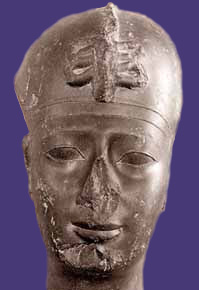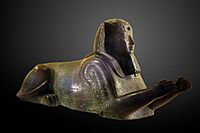Apries facts for kids
Quick facts for kids Apries |
|
|---|---|
| Wahibre | |

head of Apries, Louvre
|
|
| Pharaoh | |
| Reign | 589–570 BC (26th dynasty) |
| Predecessor | Psamtik II |
| Successor | Amasis II |
| Children | Khedebneithirbinet II |
| Mother | Takhuit |
| Died | 567 BC |
Apries (Ancient Greek: Ἁπρίης) was an ancient Egyptian pharaoh. His Egyptian name was Wahibre Haaibre. He ruled Egypt from 589 BC to 570 BC. He was the fourth king of the Twenty-sixth dynasty of Egypt. Some ancient writers called him Waphres. He is also known as Hophra in the Bible.
Contents
Pharaoh Apries' Reign
Apries became pharaoh in February 589 BC. He took over from his father, Psamtik II. Apries was a busy builder. He added new parts to temples. These temples were in places like Athribis, Bahariya Oasis, Memphis, and Sais.
In his fourth year as pharaoh, Apries' sister, Ankhnesneferibre, received an important title. She became the new God's Wife of Amun in Thebes. This was a powerful religious role for a woman.
Challenges and Conflicts
Apries' time as pharaoh had many problems. In 588 BC, he sent his army to Jerusalem. He wanted to protect it from the Babylonian army. King Nebuchadnezzar II led the Babylonians. However, Apries' forces quickly left. They seemed to avoid a big fight with the Babylonians. Jerusalem was later destroyed by the Babylonians. This happened after a long siege.
Apries' attempt to help the Kingdom of Judah failed. This led to trouble within his own army. Soldiers from Aswan rebelled.
Ancient historians say Apries fought in the Levant. He captured the city of Sidon. He also made other cities in Phoenicia surrender. But this control probably did not last long. A stone carving found in Tahpanhes tells us something important. It says Nebuchadnezzar II tried to invade Egypt in 582 BC. But Apries' army was strong enough to stop the invasion.
War in the West
To the west of Egypt, in Cyrenaica, there was a Greek city called Cyrene. Its king, Battus II of Cyrene, encouraged more Greeks to settle there. This caused problems with the local Libyan people. Their king, Adicran, asked Apries for help around 570 BC.
Apries sent his army to fight Cyrene. But his forces were badly beaten. This happened at the Battle of Irasa.
Civil War and Death
When Apries' defeated army returned home, a civil war began. This was a fight between Egyptian soldiers and foreign soldiers in the army. The Egyptian soldiers supported Amasis II. Amasis was a general who had led Egyptian forces. He had successfully invaded Nubia in 592 BC. This was under Apries' father, Psamtik II.
Amasis quickly declared himself pharaoh in 570 BC. Apries then left Egypt. He found safety in another country. In 567 BC, Apries came back to Egypt. He had help from a Babylonian army. He wanted to get his throne back. But he was likely killed in a battle with Amasis' forces.
Another story says Apries survived the battle. He was captured by Amasis. Amasis treated him well at first. But the Egyptian people demanded that Apries be punished. So, Amasis gave Apries to the people. This helped Amasis secure his rule over Egypt.
Amasis treated Apries' body with respect. He made sure Apries had a proper burial. Apries' body was taken to Sais. He was buried there with "full military honours." Amasis also married Apries' daughter. Her name was Khedebneithirbinet II. This marriage helped Amasis make his rule seem more rightful.
Monuments
Apries had an obelisk built in Sais. An obelisk is a tall, narrow stone pillar. Later, a Roman Emperor named Diocletian moved it. He placed it at the Temple of Isis in Rome. Today, this obelisk stands in front of the Santa Maria sopra Minerva church in Rome. It is known as the Pulcino della Minerva.
-
Sphinx of Pharaoh Apries, now in the Louvre Museum
See also
- Twenty-sixth Dynasty of Egypt family tree
- List of biblical figures identified in extra-biblical sources



